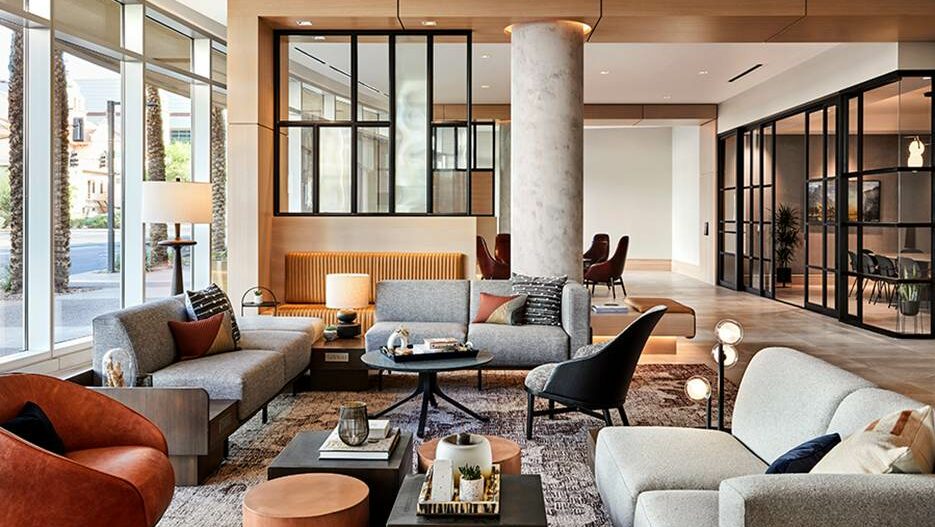‘The Future of Hospitality Isn’t Defined by Walls, But by the Experiences Those Walls Enable,’ Says Robert Polacek
In partnership with APG

In an era where business blends with leisure and hotel lobbies double as offices, lounges, and social hubs, Robert Polacek is challenging the hospitality industry to catch up with how people actually live and work today. As Partner and Creative Director at RoseBernard Studio, Polacek isn’t just designing hotel layouts; he’s creating a renewed life in motion.
“It’s what I call the great blur,” Polacek says. “The old nine-to-five model, the idea of clocking in, sitting in a cubicle, going home; it’s a relic. We live fluid lives now, and our spaces need to reflect that.”
Rigid Rooms, Responsive Lives
Polacek points to a major disconnect between the infrastructure of hotels and the evolving behavior of today’s travelers. Most hotel spaces, he argues, are carved out into rigid silos: one room for sleeping, another for eating, and a tucked-away business center that feels dark and uncomfortable rather than helpful. “These traditional centers are often in a siloed corner where no one wants to be.”
The truth is guests no longer travel for just one reason. A single trip can span board meetings, market strolls, video calls, and sunset cocktails, all in a single day. “Trips are no longer defined by work or play. It’s all one experience now,” he says. “People are closing deals in the morning and exploring the city in the afternoon. That’s just the way we live.”
And yet, hotel spaces haven’t caught up.
Lobbies With A Pulse
Polacek is advocating for a fundamental rethink of hospitality spaces, transforming them from transactional to experiential, from fixed to flexible. That means guest rooms that function as micro studios with layered lighting, ergonomic seating, and tables that double as desks. It means designing lobbies that are not just transient spaces for check-ins, but social hubs with communal tables, integrated power, quiet alcoves, and a bar that serves coffee in the morning and cocktails at night.
“Most business travelers only stay for about 1.5 days on average at one hotel. That means every touchpoint matters,” he explains. “Design can turn these in-between moments into memorable ones. Give me a table by the window to work, not a desk shoved against the wall. That’s modern luxury.”
ROI by Design: Fluidity as a Business Strategy
Beyond the aesthetics, there’s clear business case for this new approach. “Designing for flexibility isn’t just better for the guest; it may help increase revenue,” Polacek remarks. By activating underutilized areas, turning breakfast-only restaurants into a daytime co-working space, or the unused business center into a boutique retail experience, hotels can monetize every square foot.
This strategy has the potential to build guest loyalty. “I now choose hotels based on their public spaces,” Polacek admits. “The room is almost an afterthought. I want to know what kind of experience I’m stepping into the moment I enter the lobby.”
Not Defined by Walls
For Polacek, the future of hospitality lies in adaptability. “The most successful hotels of the next decade won’t be defined by walls, but by the experiences those walls enable,” he says. “We’ve already started applying this philosophy in our projects, creating small social nooks, flexible layouts, and immersive lobby experiences that feel curated, not corporate.”

At one recently completed hotel, the RoseBernard team designed a lobby with a modular coffee bar that transforms into a cocktail lounge, along with semi-private seating zones that encourage both work and connection. “You can sit in the corner, get things done, and still feel part of the room,” he says. “It’s about designing for that balance: alone, but not isolated.”
Polacek also sees a cultural shift in how one defines luxury. “Luxury used to be a race to the top: more marble, more gold. Now? It’s a desk facing the perfect angle of a window, oozing natural light. It’s a chair that’s actually comfortable to sit in for a few hours. These things matter.”
What once felt indulgent is now expected: Wi-Fi that works, rooms that support multiple modes of living, and experiences that feel personal and human. “Someone once said to me, ‘Wow, someone really thought about this.’ That’s the new luxury; spaces that feel intentional.”
Rethinking the Blueprint
While Polacek acknowledges that change is hard, especially when working within the constraints of legacy infrastructure, he believes the biggest opportunities are in rethinking how space is used, without just adding more of it.
“At RoseBernard, we design for life, not just for travel,” he says. “We create adaptable, multi-functional environments that empower guests to curate their own experience, whether they’re focused on productivity, relaxation, or social connection.”
